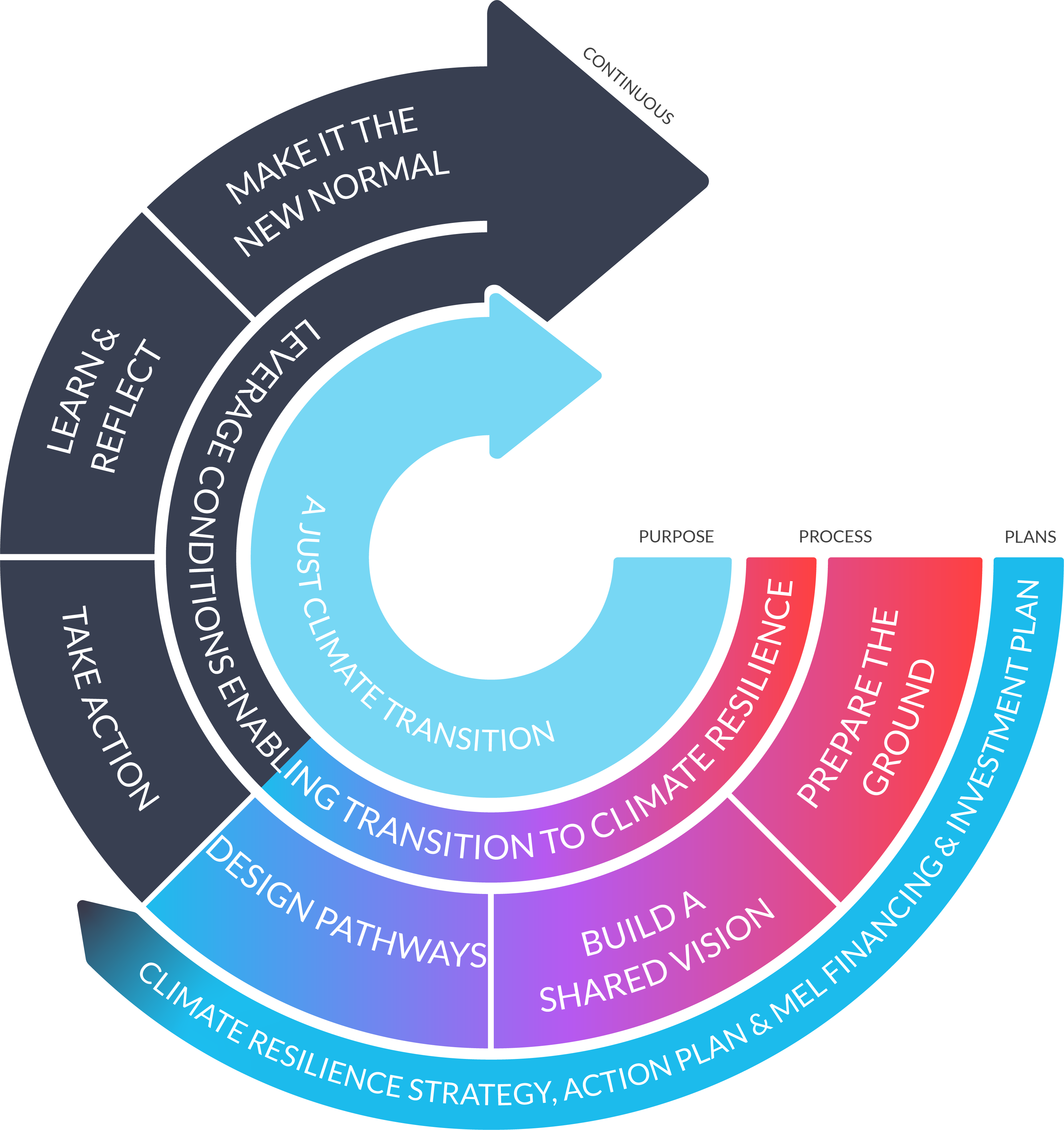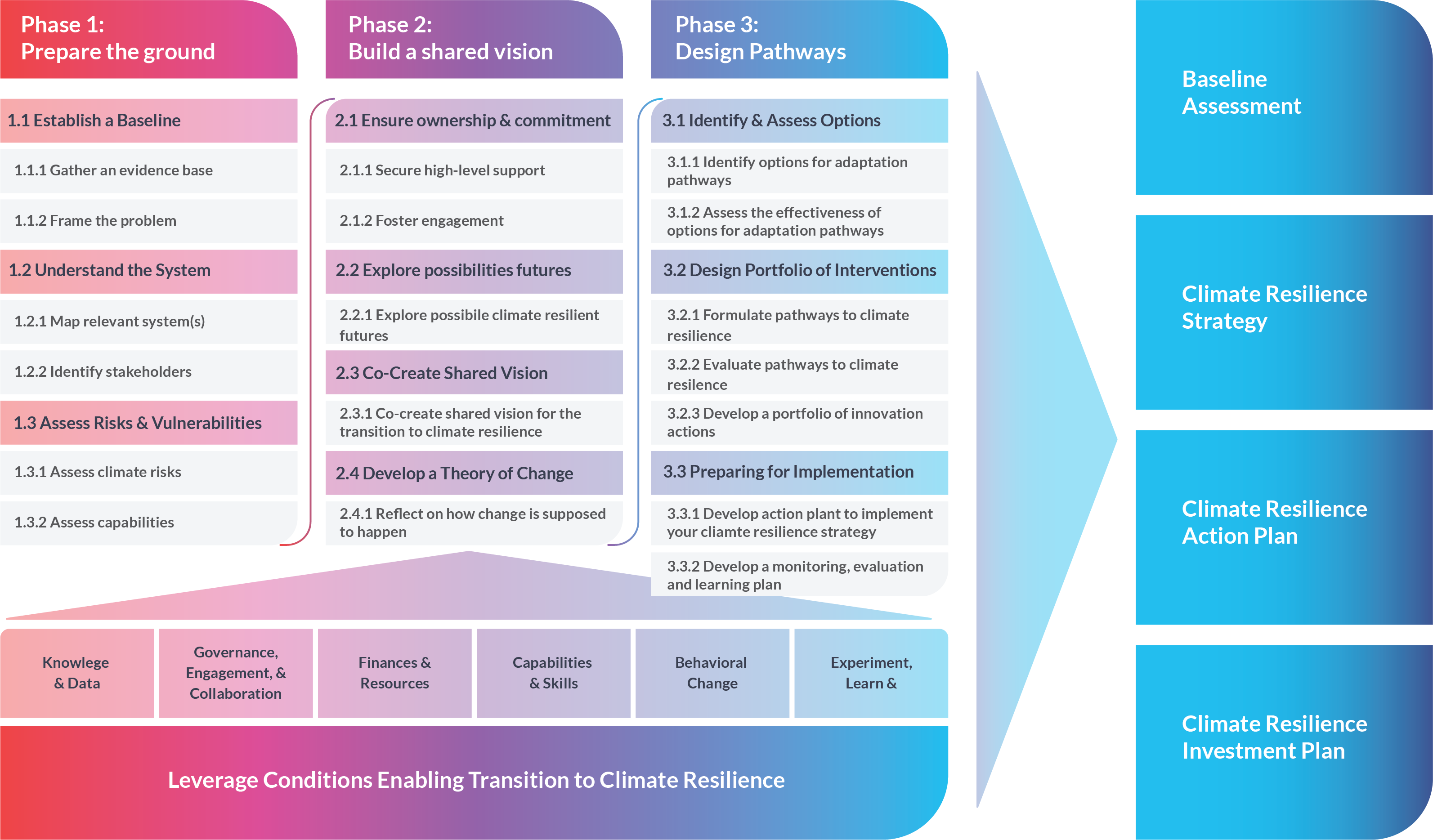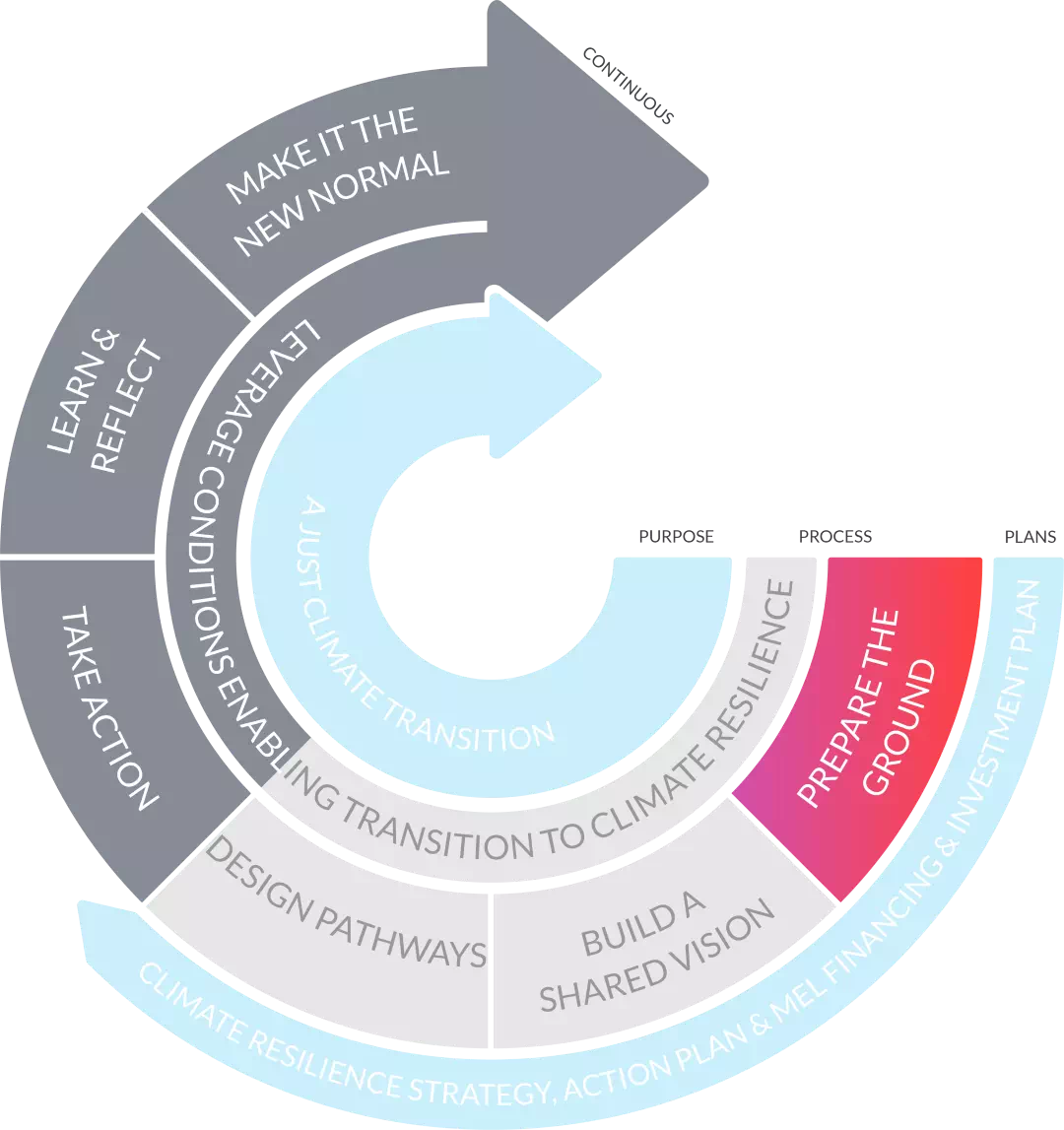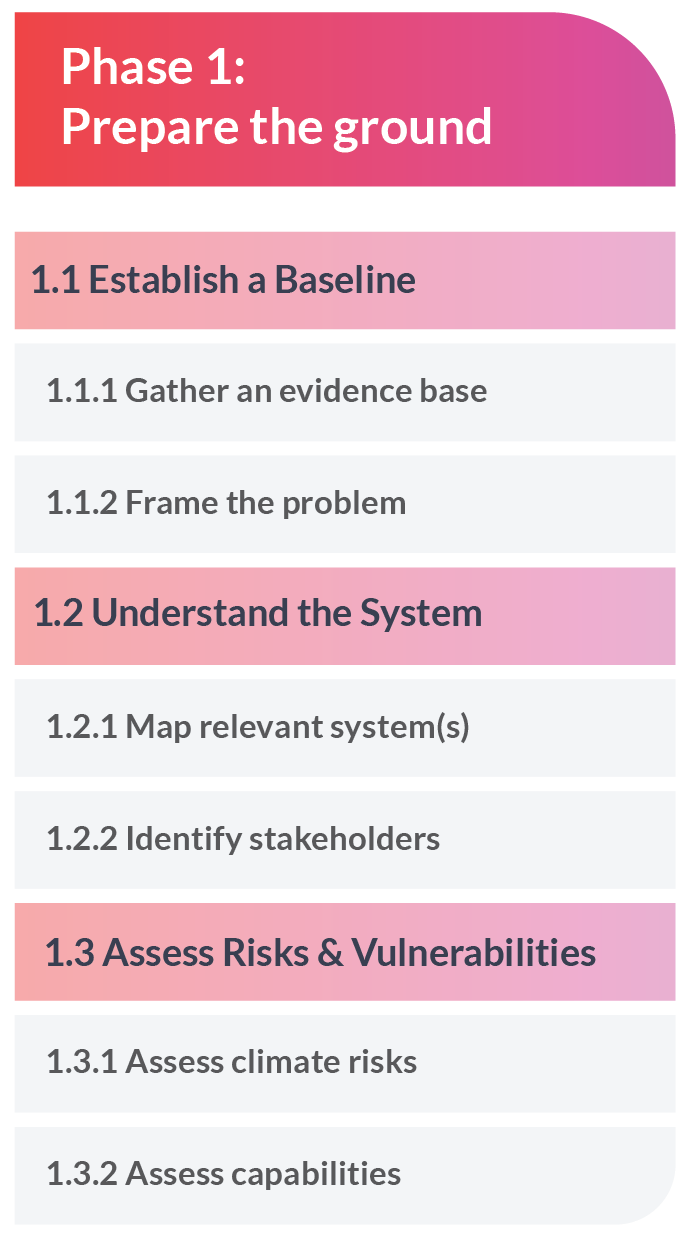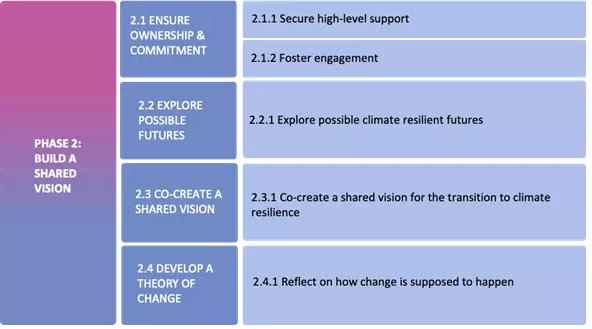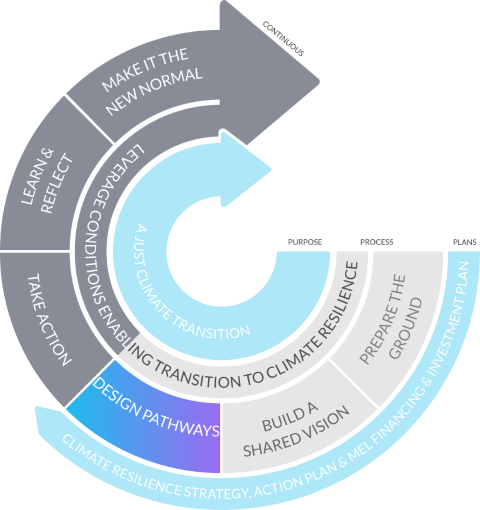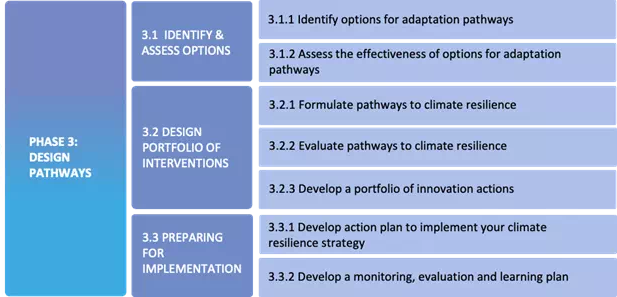The
Regional Resilience Journey framework provides task-by-task guidance, including
methods,
tools and checklists, to help regions at all maturity levels create or improve their Climate
Resilience Strategies and Action Plans. It applies a systemic approach, just transition and
just resilience principles and harnesses transformative
innovation. Successful strategies
for climate adaptation and transitioning to climate resilience combine interventions across
multiple levers of change in a coherent portfolio of actions, outlining how each
intervention contributes to progress to
wards the desired outcomes.
Key Approaches used in the Regional Resilience Journey
Systems thinking: This approach is designed to help us grasp the
interconnectedness and
interdependencies of our world. It builds from the idea that none of our human
interactions exist in isolation and therefore the changes applied to one part of a given
system can have ripple effects in other parts of that system and those connected.
Transformative Innovation: Innovation is defined as the process of conceiving new
ideas,
methods, practices, or solutions that have the potential to generate a positive impact
and value. For innovation to be transformative, it needs to go a step further in
generating new patterns that create significant and lasting change. Systems thinking is
essential for transformative innovation.
Systems change: It is an intentional process that aims at addressing the root
causes of
complex social and ecological issues that are often embedded in multiple interactions of
cause and effect. It seeks to alter the components and structures that cause systems to
behave in a certain way, with a view to establish new patterns of behaviour.
Portfolio: A portfolio approach shifts attention from the merits of individual
projects
to the potential for integration: facilitating synergies across and between projects to
effect systemic change. The intent is to transform a place by creating an ecosystem of
interventions and/or solutions.
Levers of change: These can be understood as areas of work or entry points for
interventions that have the potential to unlock wide-ranging and positive change in a
given place, industry or both. In the context of climate adaptation, some examples of
powerful levers of change are policy, finance,
technology, and citizen engagement, among
others, especially if the interventions are designed following an innovation approach.
Whole-of-government approach: The approach refers to the joint activities
performed by
diverse ministries, public administrations and public agencies in order to provide a
common solution to particular problems or issues and involve some form of cross-boundary
work.
Multi-level governance: Multi-level governance refers to coordinated actions
across
different levels of governance from the Member States and local and regional authorities
to the European Union, based on partnership and aimed at developing and implementing
common policies.
Transformational climate adaptation: This approach seeks to move beyond reactive
and
incremental adaptation of existing systems. Instead, it seeks fostering systemic shifts
that address the adaptation gap and promote long-term prosperity in the face of climate
change. It delivers place-based transformation by implementing an interrelated portfolio
of interventions across multiple levers of change, to drive significant and lasting
societal change.
Risk-informed decision making: This approach is about making risk management
related
decisions in uncertain, unpredictable environments such as those that a future climate
provides. It is about properly considering risks by building and weighing-up possible
scenarios, consider risk drivers, and trade-offs.
The framework considers various regional circumstances and fosters integrated work on
different
enabling conditions to maximise institutional, social, and financial powers. Acknowledging
the
inter-connectiveness of different fields of work, the transformative perspective aims to
look
beyond climate adaptation and to identify synergies with related sectors (e.g., water
management
, while also strengthening collaboration and multilevel and multistakeholder engagement).
This guidance is designed to support regions in developing transformational Climate
Resilience Strategies and Action Plans, focusing on the first three phases of the Regional
Resilience Journey process.
A systemic approach to accelerating the transition to climate resilience
The Regional Resilience Journey framework promotes transformational adaptation by adopting a
systemic approach that addresses climate resilience in its full complexity, rather than
viewing it as a set of isolated issues. This approach encourages regions and communities to
consider all relevant components and relationships, framing interventions holistically to
shape a desirable future.
By taking a systemic perspective, regions can identify leverage points and incorporate
diverse stakeholder perspectives, balancing short-term disaster risk reduction with
long-term prevention and adaptation while avoiding maladaptation. The Regional Resilience
Journey supports a whole-of-government and multi-level governance approach, breaking down
departmental siloes and fostering meaningful stakeholder engagement at every stage of the
process. This requires a foundation of transdisciplinary knowledge and data to ensure
informed decision-making and collaborative action.
The Regional Resilience Journey fosters an integrated government and multi-level governance
approach to support regions in work beyond departmental siloes, supports meaningful
engagement of stakeholders across all relevant stages of the journey, and requires an
underpinning transdisciplinary knowledge and data.
An iterative and multi-layered process
No transformative adaptation to climate resilience is linear. Therefore, allowing for
experimentation, learning, and continuous iteration is crucial. The Regional Resilience
Journey is designed to accommodate multiple iterations—while the phases follow a sequential
logic, many of the tasks within each phase will run in parallel or in repeated cycles. Over
time, regions are encouraged to undertake parts of the journey, and the journey itself,
multiple times, revisiting assumptions and learning from new insights. Gaps in knowledge,
data, or finance will emerge as different elements are explored, or stakeholders engaged.
Strategically, it will be valuable to undergo iterations with diverse focuses, such as
applying different approaches or zooming in on specific sectors.
Just Climate Resilience
The Regional Resilience Journey is designed to support regions in transitioning to climate
resilience in a just and equitable manner. It integrates principles, processes, and
practices to ensure distributive justice (fair allocation of burden and benefits),
procedural justice (participatory decision-making processes), and recognition (respect and
robust engagement with diverse cultures and perspectives), as defined by the IPCC 2022.
The IPCC stresses that just transitions need targeted and proactive measures to ensure that
any negative social, environmental or economic impacts of economy-wide transitions are
minimised, while benefits are maximised for those disproportionally affected.
The Regional Resilience Journey supports regions in co-designing their adaptation strategies
with a participatory approach, recognising the role that vulnerable populations play in a
just transition. It will help regions in enabling a governance structure that fosters a
meaningful participation of relevant stakeholders (including vulnerable communities), e.g.,
through leveraging innovation engagements, mapping exercises, co-creation, etc.
Financing transformative adaptation
The Regional Resilience Journey approach emphasises the importance of mobilising the
significant investments needed to achieve the transition to climate resilience. This
increasingly demands regions to move from being applicants and recipients of public funds to
being stewards of adaptation capital - leading a financial planning process to scale and
target adaptation finance which makes achieving those regional transformations possible.
Therefore, and in parallel to the main Regional Resilience Journey, we have developed an
Adaptation Investment Cycle to support the development of a Climate Resilience Investment
Plan, which translates the ambitions into bankable
projects.
The process for developing a Climate Resilience Investment Plan has been designed to
encourage the financing of a region’s strategy and pathways in their entirety, whilst
recognising that regions will be starting from different levels of maturity and capability.
The Adaptation Investment Cycle is aligned with the main steps of the Regional Resilience
Journey, meaning that certain inputs are relevant to both. They also intersect at key
stages, particularly in the development and assessment of adaptation options, pathways, and
action plans, where financial viability and economic performance play a crucial role in
determining whether to proceed with various actions. To help clarify these connections, we
have included links throughout the guide to relevant inputs and outputs that support the
development of a Climate Resilience Investment Plan. A full overview of the links between
the two processes can be found in Appendix B. A similar guide is provided in the finance
section, illustrating how the Regional Resilience Journey aligns with the steps in the
Adaptation Investment Cycle.
Before embarking on your Regional Resilience Journey, take time to
reflect on
the outputs you aim to produce as part of your Climate Resilience
Strategy.
We suggest the following:
A Climate Resilience Baseline
Assessment drawing on key elements of
the ‘Prepare the ground’ phase, including in particular:
- An assessment of current and predicted future climate risks and
vulnerabilities, including a prioritisation of the key and most
urgent ones.
- A description of the different sectors and community systems
impacted by the transition to climate resilience, including
interdependencies and cascading effects.
- An assessment of adaptive capacities,
competences and resources
relevant for achieving a just transition to climate resilience,
including a list of needs that should be addressed as a matter
of
priority.
- A map of stakeholders, vulnerable groups and inequities,
including
a stakeholder assessment matrix mapping the interest and
influence
of each target group, and their impact in regional resilience.
A Climate Resilience Strategy drawing on key elements of the
‘build a
shared vision’ phase as the ‘design pathways’ phase, including:
- A shared vision of the climate resilient future that the region
wants to achieve, providing a compelling, engaged, co-created
narrative that allows you to mobilise the stakeholders in your
region required to implement and sustain your plan.
- An overview of identified regional transformation potentials and
possible climate resilient futures, including the key enabling
conditions that regions and communities would need to
address and
strengthen.
- A set of preferred climate adaptation
pathways, outlining strategic
sequences of preferred adaptation options to be implemented
against
a long-term time horizon as risk-based conditions continue to
change.
- A co-developed stakeholder engagement strategy and participatory
designpeer process, including the description of engagement
mechanisms and structures.
A Climate Resilience Action Plan covering key elements of the
‘design
pathways’ phase, including:
- A description of the near-term that the region will conduct to
implement its adaptation strategy, including priority of these
actions, roles, responsibilities, and resources.
- A monitoring, evaluation and learning framework for implementing
the
action plan, adaptation pathways, and investment plan.
- An innovation portfolio, outlining a
set of innovation activities
that support the adaptation pathways.
A Climate Resilience Investment Plan
which translates the shared vision
into a pipeline of bankable projects, ensuring the resources are
available to deliver the climate resilience strategy and action plan
(see guidance on the Adaptation Investment Cycle on this). Its key
components include:
- A summary of the investment context in your region, including an
assessment of current and future costs, and the relevant
investment
processes and criteria.
- A catalogue of existing sources and instruments in your region
to
finance adaptation and future options you are planning to
explore.
- A series of investment strategies for the adaptation pathways
developed in your climate resilience strategy.
A pipeline of bankable projects associated with the action plan, along
with
actions to improve the enabling conditions for financing.
A note on Time Horizons
One of the challenges of working towards climate resilience is the
long-term nature of the planning needed. Adaptation pathways are
solutions to be implemented over longer periods of time (spanning
time
horizons of 50-100 years or more) in a process that starts today,
but
which not only depends on actions taken by us in the present but
also on
those taken by future generations. This thinking contrasts with the
more
typical time horizons that are usually associated with addressing
policy
problems, which, in many cases, demand immediate results and
outcomes
and apply shorter-term tools and methods. Taking a long-term
perspective
often also leads to economic and financing challenges due to the
deep
uncertainty involved in the future projections, as well as the
potential
disconnect between when investment happens to when its benefits are
reaped.
To address this issue, we take inspiration from the way in which past
generation(s) thought about their legacy. This has been called
cathedral
thinking and refers to “the undertaking of long-term projects or
goals
that are initiated for the benefit of future generations and are
destined to be completed long after the original visionaries and
builders are gone. This label represents the creation of something
that
inherently requires more time than those who design it could ever
hope
to experience themselves: that is, a way of planning that benefits
not
the designers but those who will come after them.“
How can you incorporate this way of thinking into your Climate
Resilience
Strategy? The most important point is to have a strong sense of
purpose
and a clear vision. Many of the elements of the Regional Resilience
Journey have different time frames.
Your adaptation pathways can be very long-term (e.g., up to 100
years).
The vision and the theory of change underpinning your pathway should
aim
to close the gap between long-, mid- and shorter-term results; in
that
respect, your vision should be attainable against a time horizon
that
allows for significant transformations to take place (for instance,
in
50 years’ time). In practical policy terms, your Climate Resilience
Strategy might have a mid-term ambition of 10-20 years, with your
Climate Resilience Action Plan focusing on short-term implementation
over the next 3-5 years.
What is important is to keep a strong sense of purpose and an eye on
your
long-term goals. The second important aspect is to understand that
many
of the actions that can be implemented in the short- and
medium-terms
are preparatory and will build the conditions for results in the
long-term. The key question to answer is “what should we be doing in
the
next few years to ensure we are adapting well for the long term”.
Your region will define the specific time frames for each these
components, depending on the adaptation challenges that you want to
address. We invite you to maintain a long-term perspective
throughout
implementation of the Regional Resilience Journey.
P2R deliverable templates to download:
- Pathways2Resilience Baseline Assessment Template
- Pathways2Resilience climate resilience action
plan
- Pathways2Resilience climate resilience investment
plan
- Pathways2Resilience climate resilience
strategy
To make the Regional Resilience Journey framework practical and
accessible, the P2R Climate Toolbox has been developed as an essential
resource for regions seeking to enhance their climate resilience.
This toolbox offers clear guidance on the tasks involved in the RRJ,
alongside over 300 tools and resources. Click here to access it.

